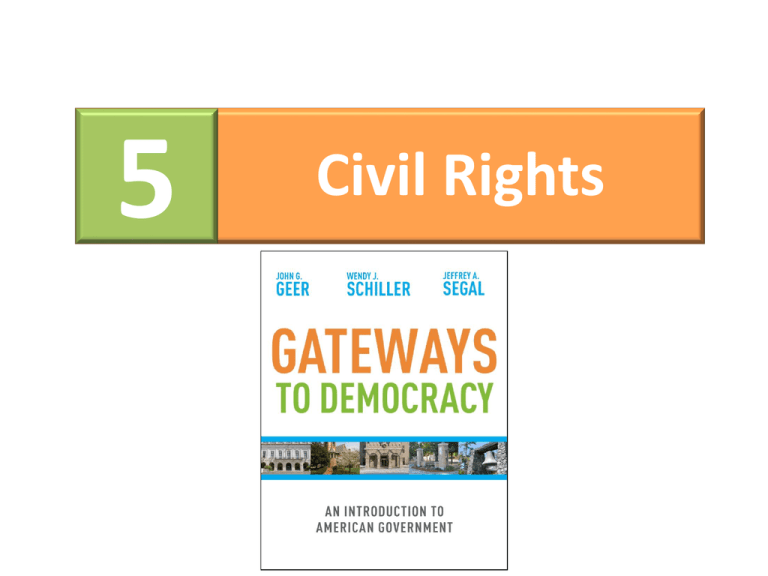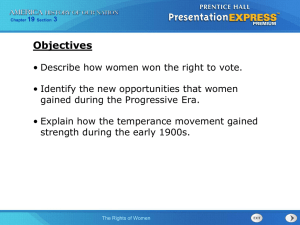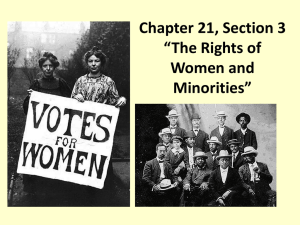
5
Civil Rights
Civil Rights
Although the Declaration of Independence declared that “All
men are created equal,” the 1787 Constitution had little to say
about equality, at least as the concept is understood today.
Civil rights are rights related to the duties of citizenship and the
opportunities for participation in civic life that the
government is obliged to protect. These rights are based on
the expectation of equality under the law.
Civil Rights vs. Civil Liberties
Civil rights differ from civil liberties in that while
government is the only authority that could suppress
liberties, for example by suppressing freedom of
speech or forbidding a certain religious belief, both
government and individuals have the capacity to
engage in discrimination by treating people
unequally: the government through laws that
discriminate and individuals or businesses through
actions that discriminate.
The Government and Civil Rights
The government can take three different roles when it comes to
civil rights.
• It can engage in state-sponsored or public discrimination by
actively discriminating against people.
• It can treat people equally but permit private discrimination
by allowing individuals or businesses to discriminate.
• It can try, as it has since the 1960s, both to treat people
equally and to prevent individuals or businesses from
discriminating.
The Constitution and Civil Rights
The Founders were not much concerned with equality as it is
understood today.
• Many owned slaves
• The words “slave” and “slavery” do not appear in the
Constitution, but states were required to return runaway
slaves and the importation of slavery was allowed until 1808.
• The states had authority over voting, and most states
restricted the right to vote to free males with a certain
amount of property.
Introducing Civil Rights into the
Constitution
Civil War Amendments
• 13th Amendment
– Ended Slavery
• 14th Amendment
– Makes people born in the United States Citizens
– Equal protection under the law
• 15th Amendment
– Universal adult male suffrage
• 19th Amendment
– Women’s suffrage
• 26th Amendment
– Universal adult suffrage
Racial Segregation and Discrimination
Legal Restrictions on Civil Rights
Slavery
• Missouri Compromise (1820)
- Banned slavery in the territories that were north of
the southern border of Missouri, thus keeping most
of the vast lands in the Louisiana Purchase free.
• Compromise of 1850
- Allowed territories captured in the Mexican War to
decide for themselves whether to be free or slave and
denied alleged fugitive slaves the right to a jury trial.
Legal Restrictions on Civil Rights
continued
• Kansas-Nebraska Act (1854)
- Undid the Missouri Compromise by allowing each
territory to vote as to whether to allow slavery or not
• Dred Scott v. Sandford (1857)
- No black—slave or free—could be an American citizen,
and thus could not sue in a federal court.
- Blacks were “beings of an inferior order” who had “no
rights which the white man was bound to respect.”
- The Declaration’s statement that “all men are created
equal” did not include those of African heritage.
Dred Scott v. Sandford (1857)
In 1846 Dred Scott, a black slave
pictured here with his family, sued
for his freedom, claiming that since
his owner had taken him to a free
territory, he should be free.
The Supreme Court said no, and
went further to say that Scott, as an
African American, had no standing to
sue, and that Congress could not
prohibit slavery in any territory. The
1857 ruling pleased southerners but
infuriated northerners.
Racial Segregation and Discrimination
The Emancipation Proclamation did not end discrimination.
• Black Codes
– Prevented freedmen from voting, owning land, or leaving their
plantations.
• Reconstruction
– Civil Rights Act of 1866 guaranteed the right of freedmen to make
contracts, sue in court if those contracts were violated, and own
property.
– Congress also established military rule over the former Confederate
states, which would end when a state passed a new state constitution
that guaranteed black suffrage and when it ratified the Fourteenth
Amendment.
Ku Klux Klan
Founded by Confederate veterans in 1866, the Klan was a
terrorist organization aimed at restoring white supremacy.
• Congress responded by passing:
- Civil Rights Act of 1871
» enforce 14th Amendment
» protection from Klan violence
- Civil Rights Act of 1875
» equality in public accommodation
– All declared unconstitutional by Supreme Court
After Reconstruction
Reconstruction ends in 1876 and the South is no
longer under military occupation.
• Mississippi never ratifies the 13th Amendment until 1995.
• Klan violence increases and the presence of the Klan is
evident in private and government agencies throughout the
South and even in some Northern states like Indiana.
Denial of Rights by the States
Despite the 15th Amendment, states denied freed men
the right to vote through a variety of laws.
• Poll taxes limited the voting of poor blacks (as well as poor
whites).
• The white primary excluded blacks from Democratic primaries
meaning that blacks had no effective vote at all.
• Literacy Tests involved reading and interpreting difficult
passages, sometimes in foreign languages
• Grandfather clauses gave exemptions to those whose
grandfathers had been eligible to vote.
Jim Crow Laws
Jim Crow laws enforced segregation of whites and
blacks in all public places.
• Plessey v. Ferguson (1896)
– Separate but equal doctrine
Woman’s Suffrage
Neither the Declaration nor the Constitution made any provision for
women’s rights. Rather, the states continued the English policy of
coverture.
• In 1848, leaders of the women’s suffrage movement met in Seneca
Falls, New York, to organize for the right to vote.
• The 19th Amendment to the Constitution would not be passed until
1920.
Woman’s Suffrage by States
Women’s Rights
Even after the passage of the 19th Amendment, women
found themselves restricted by law and
discriminated against in a variety of areas.
•
•
•
•
•
Right to own property
Right to divorce
Access to birth control and abortion
Right to equal access to higher education
Right to equal work and equal pay
Equal Rights Amendment
First introduced in 1921 by Alice Paul, and passed by Congress in
1972, the Equal Rights Amendment (ERA) said:
“Equality of Rights under the law shall not be denied or abridged
by the United States or any state on account of sex.”
• Failed to be ratified by 3 states
• Title IX of the Education Amendments
– “No person in the United States shall, on the basis of sex, be excluded
from participation in, be denied the benefits of, or be subjected to
discrimination under any education program or activity receiving
Federal financial assistance. . .”
Equal Rights Amendment
Other Forms of Discrimination
• Chinese Exclusion Act of 1882
– Barred immigration of Chinese to America.
• Public segregation of Hispanics in the south and west
• Exclusion of Native Americans as citizens (ends with the
passage of the Indian Citizenship Act of 1924 )
– In 1823, the Supreme Court declared that Native Americans were merely
inhabitants, “an inferior race of people, without the privileges of citizens.”
• Immigration Quotas
– The Immigration Act of 1924 placed quotas for ethnic groups based on the
proportion of Americans from each nationality resident in 1890, thereby
severely limiting the number of whites considered to be of “lower race,” that
is, those from southern and eastern Europe.
• Japanese Interment during World Ward II
– In Korematsu v. United States (1944) the Supreme Court decision upholding
the detention of Japanese Americans during World War II.
Other Forms of Discrimination
The End of Legal Restrictions
on Civil Rights
Brown v. Board of Education (1954)
• Separate schools were inherently unequal, even should
facilities be essentially similar.
• Segregation in schools violated the equal protection clause
of the Fourteenth Amendment.
Brown II (1955)
• Gave the oversight of desegregation to Federal Courts,
taking the power away from the states.
End of Civil Rights Restrictions
continued
Civil Rights Act of 1957
• Established U.S. Commission on Civil Rights to investigate
civil rights violations
• Created Civil Rights division of Department of Justice to
enforce the 15th Amendment
Civil Rights Act of 1960
• Renewal of 1957 act
• Criminal laws against racially motivated bombings and
burnings
The Civil Rights Act of 1964
Civil Rights Act of 1964
• 11 titles
• 2, 6, & 7 most important
- 2 – bars discrimination in places of public
accommodation
- 6 – bars racial discrimination in any federally funded
program
- 7 – bars discrimination in hiring, firing, or any other
disc. by business or labor orgs. on account of race,
religion, sex or national origins, outlawed poll taxes
and literacy tests and created the EEOC.
The Voting Rights Act of 1965
The Voting Rights Act of 1965
• Banned literacy, interpretation, and other such tests for
voting.
• It required states with low voter registration levels to
receive Justice Department approval for any changes to its
voting laws.
• It also established new criminal penalties for those who
sought to keep people from voting on account of race.
Ending Anti-Miscegenation Laws
Also known as Miscegenation Laws, banned the marriage of and
sometimes sexual relations between people of different races.
• Loving v. Virginia (1967)
Affirmative Action
Even after the passage of Civil Rights laws, minorities and
women continued to face discrimination in hiring and in
access to educational institutions. In an attempt to redress
these historical wrongs, the government created programs
known as Affirmative Action.
• Affirmative action is a term coined in the 1960s to describe
programs that were intended to remove “artificial barriers” to
employment and education for people who had been
historically prevented access because of discrimination.
– Seek out and hire/admit qualified minority and female candidates
Affirmative Action vs. Quotas
Because the government requires that public educational institutions and
businesses seeking government contracts conform to affirmative action
programs, some believed that this meant the government required them
to employ/admit a certain number or “quota” of women and minorities.
• The Supreme Court has consistently held that quotas are unconstitutional
while upholding affirmative action programs.
– Businesses that are required to employ a certain number of women or
minorities can avoid the requirements if they can show that there was
a shortage of reasonably qualified female or minority applicants
– Colleges and universities cannot set aside a number or percentage of
seats for minority or female candidates, but may use race as one of
many factors in admissions.
• Legacy
Sexual Identity
The Stonewall riots became the signature event
of a growing gay rights movement. Activists soon
formed the Gay Liberation Front, which
established branch organizations around the
world.
• Many states passed laws that specifically targeted gay
sex.
– Bowers v. Hardwick (1986)
– Lawrence v. Texas (2003)
Sexual Identity and the
Loss of Civil Rights
Don’t Ask, Don’t Tell
• Prior to this policy, simply being a gay or lesbian citizen,
without any evidence of homosexual activities, was sufficient
grounds for discharge from the armed forces.
• Under “Don’t Ask, Don’t Tell,” sexual identity alone is not a
ground for discharge, but lesbians, gays, or bisexuals can still
be discharged for engaging in homosexual relationships or for
discussing their sexual orientation.
– It is estimated that over 15,000 service men and women have been
discharged under this policy. Some served in strategic positions, like
languages, where the military already faces a shortage.
The Right to Marry
Congress passed and President Clinton signed the Defense
of Marriage Act in 1996.
• Defines marriage, for the purpose of federal law, as between a
man and a woman and declares that states do not have to
recognize same-sex marriages performed in other states.
• Violates the “full faith and credit” clause of the Constitution
• Denies states that allow gay marriage the historical right of
having those marriages recognized by other states.
• Violation of the 14th Amendment’s “equal protection clause”.
States Approving Same Sex Marriage
Views on Same-Sex Marriage
The Employment
Non-Discrimination Act
Members of the LGBT community are not protected under the
1964 civil rights acts.
• The Employment Non-Discrimination Act (ENDA) would
provide basic protections against workplace discrimination on
the basis of sexual orientation or gender identity.
- Extend federal employment discrimination protections to sexual
orientation and gender identity.
- Prohibit public and private employers, and labor unions from using an
individual's sexual orientation or gender identity as the basis for
employment decisions, such as hiring, firing, promotion or compensation .
- Provide for the same procedures, and similar, but somewhat more
limited, remedies as are permitted under Title VII and the Americans with
Disabilities Act
- Applies to Congress and the federal government, as well as employees of
state and local governments
Disability Rights
• The landmark Americans with Disabilities Act (ADA) (1990)
requires public and private employers to make “reasonable
accommodations” to known physical and mental limitations of
employees with disabilities and, if possible, to modify
performance standards to accommodate an employee’s
disability.
Racial and Religious Profiling
The use by police of certain racial, ethnic, or religious
characteristics in determining whom to investigate for particular
kinds of crimes, has become controversial because evidence has
mounted that profiling entails unequal treatment under the law.
Voting Rights for Felons
Voting rights for felons vary greatly from state to state,
leaving some to conclude that inequality still exists within
voting rights.
• Maine and Vermont allow prison inmates to vote.
• Thirteen states allow felons to vote upon release from
prison.
• Twenty-five more states allow them to vote upon
completion of probation or parole.
• Ten states do not automatically restore voting rights, with
the specifics of restoration varying among those states.
Voting Rights for Felons
Illegal Immigrants
The Fourteenth Amendment’s equal protection
clause prohibits states from denying to any person—in
other words, not just citizens—equal protection under
the law.
• Immigration Reform
– Path to legal citizenship?
– Increases in guest worker visas?
Illegal Immigrants
Sexual Harassment
The problem of discrimination on account of sex can take many
forms, and one of the most prevalent in the workplace is
sexual harassment.
• Survey data reveal that nearly 60 percent of women report
potentially harassing behaviors at work.
• The Supreme Court recognizes two distinct types of sexual
harassment.
– Quid pro quo, where supervisors link the benefits of employment to
sexual favors.
– Whenever one or more employees establish, on account of sex, a
hostile work environment, one that interferes with a worker’s ability
to do his or her job.
Gender Equality in the Workplace
Unfortunately, true pay equity has not been achieved in
the American workplace.
• Census statistics from 2008 show that, in 2007, women
earned only 77.8 percent of what men earned.
• African American women earned only 68.7 percent, and
Latinas earned only 59 percent, of what men made.
Lilly Ledbetter Fair Pay Act
Ledbetter v. Goodyear Tire and Rubber Co.
• In 2009 Congress reversed the court ruling by passing the
Lilly Ledbetter Fair Pay Act, which President Obama signed
into law.
- The act restarts the
clock each time an
employee receives a
paycheck that has been
compromised by
discriminatory practices.
http://edlabor.house.gov/
lilly-ledbetter-fair-payact/index.shtml
Focus Questions
• What is the meaning of equality? How has its meaning
changed since the Constitution was written in 1787?
• What role has government played with regard to equality in
the past? What role does it assume today?
• What means have various groups used to secure their civil
rights? What means has government used to respond?
• What is the effect on a democracy if some of its people lack
civil rights?
• Are civil rights a gate, or a gateway, to democracy? Explain.










